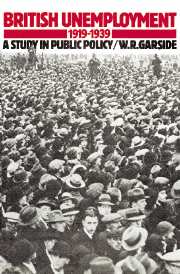Book contents
- Frontmatter
- Contents
- List of tables
- Preface
- Acknowledgements
- PART I INTRODUCTION
- PART II THE LABOUR MARKET UNDER STRAIN
- 2 Defensive action: unemployment relief and public assistance, 1919–1932
- 3 Means to an end: insurance, assistance and the categorization of the unemployed, 1932–1939
- 4 In and out of the labour market: hours of work, pensions and the school-leaving age
- PART III THE INTERNATIONAL CONTEXT
- PART IV STRUCTURAL UNEMPLOYMENT, INDUSTRY AND THE REGIONS
- PART V MACROECONOMIC POLICY OPTIONS: THEORY AND PRACTICE
- Bibliography
- Index
3 - Means to an end: insurance, assistance and the categorization of the unemployed, 1932–1939
Published online by Cambridge University Press: 21 September 2009
- Frontmatter
- Contents
- List of tables
- Preface
- Acknowledgements
- PART I INTRODUCTION
- PART II THE LABOUR MARKET UNDER STRAIN
- 2 Defensive action: unemployment relief and public assistance, 1919–1932
- 3 Means to an end: insurance, assistance and the categorization of the unemployed, 1932–1939
- 4 In and out of the labour market: hours of work, pensions and the school-leaving age
- PART III THE INTERNATIONAL CONTEXT
- PART IV STRUCTURAL UNEMPLOYMENT, INDUSTRY AND THE REGIONS
- PART V MACROECONOMIC POLICY OPTIONS: THEORY AND PRACTICE
- Bibliography
- Index
Summary
TRANSITIONAL PAYMENTS AND THE COMING OF THE UNEMPLOYMENT ASSISTANCE BOARD
The economy measures announced in mid-September 1931 succeeded temporarily in stemming the drain on gold reserves, enabling new foreign loans to be raised. But Britain was unable to shield herself sufficiently from the continuing crisis in international finance and further panic flights of foreign capital from London forced the authorities to abandon the gold standard on 21 September. Anyone who expected that a release from the discipline of gold would usher in a more expansionist budgetary stance was soon to be disillusioned. The sudden departure in November 1931 from the principle of indefinite extensions of relief payments was an instinctive reaction to the mounting insolvency of the Unemployment Fund and a reflection of the government's determination to remove any lingering doubt as to the less eligible status of those unable to qualify for insurance benefit.
Henceforth the maximum amount payable to those persons already drawing transitional benefit and to those about to do so, including those who had reached the 26 weeks' limit of insurance benefit, was to be equal to the amount of standard benefit (now reduced) to which applicants would have been entitled if they could have satisfied the contributory requirements.
- Type
- Chapter
- Information
- British Unemployment 1919–1939A Study in Public Policy, pp. 66 - 87Publisher: Cambridge University PressPrint publication year: 1990



